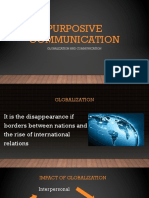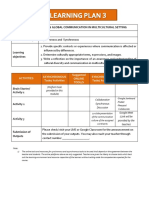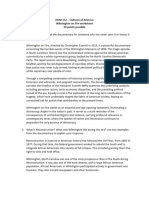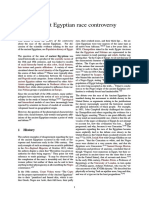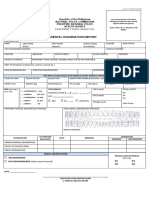100%(1)100% found this document useful (1 vote)
970 viewsPurposive Communication Ass1
Purposive Communication Ass1
Uploaded by
donnel angel anascoThe document discusses the nature and characteristics of language. It defines key linguistic terms such as mother tongue, first language, second language, and distinguishes between language acquisition and language learning. Specifically, it provides:
1) Examples of the 7 main characteristics of language - arbitrary, social, symbolic, systematic, vocal, non-instinctive and conventional, and productive and creative.
2) Definitions of mother tongue as one's native language learned from birth, and first language as the language one is competent in before starting to learn a new language.
3) Clarification that second language refers to another language being learned after the first language.
4) An explanation that language acquisition is a sub
Copyright:
© All Rights Reserved
Available Formats
Download as DOCX, PDF, TXT or read online from Scribd
Purposive Communication Ass1
Purposive Communication Ass1
Uploaded by
donnel angel anasco100%(1)100% found this document useful (1 vote)
970 views3 pagesThe document discusses the nature and characteristics of language. It defines key linguistic terms such as mother tongue, first language, second language, and distinguishes between language acquisition and language learning. Specifically, it provides:
1) Examples of the 7 main characteristics of language - arbitrary, social, symbolic, systematic, vocal, non-instinctive and conventional, and productive and creative.
2) Definitions of mother tongue as one's native language learned from birth, and first language as the language one is competent in before starting to learn a new language.
3) Clarification that second language refers to another language being learned after the first language.
4) An explanation that language acquisition is a sub
Original Description:
it tackles about the purpose of Communication
Copyright
© © All Rights Reserved
Available Formats
DOCX, PDF, TXT or read online from Scribd
Share this document
Did you find this document useful?
Is this content inappropriate?
The document discusses the nature and characteristics of language. It defines key linguistic terms such as mother tongue, first language, second language, and distinguishes between language acquisition and language learning. Specifically, it provides:
1) Examples of the 7 main characteristics of language - arbitrary, social, symbolic, systematic, vocal, non-instinctive and conventional, and productive and creative.
2) Definitions of mother tongue as one's native language learned from birth, and first language as the language one is competent in before starting to learn a new language.
3) Clarification that second language refers to another language being learned after the first language.
4) An explanation that language acquisition is a sub
Copyright:
© All Rights Reserved
Available Formats
Download as DOCX, PDF, TXT or read online from Scribd
Download as docx, pdf, or txt
100%(1)100% found this document useful (1 vote)
970 views3 pagesPurposive Communication Ass1
Purposive Communication Ass1
Uploaded by
donnel angel anascoThe document discusses the nature and characteristics of language. It defines key linguistic terms such as mother tongue, first language, second language, and distinguishes between language acquisition and language learning. Specifically, it provides:
1) Examples of the 7 main characteristics of language - arbitrary, social, symbolic, systematic, vocal, non-instinctive and conventional, and productive and creative.
2) Definitions of mother tongue as one's native language learned from birth, and first language as the language one is competent in before starting to learn a new language.
3) Clarification that second language refers to another language being learned after the first language.
4) An explanation that language acquisition is a sub
Copyright:
© All Rights Reserved
Available Formats
Download as DOCX, PDF, TXT or read online from Scribd
Download as docx, pdf, or txt
You are on page 1of 3
PURPOSIVE COMMUNICATION
August 14, 2019
Donnel Angel P. Añasco
BS Criminology 1st – A
Submitted to: Prof. Bernadette Fernan
1. What is the nature of language and give specific examples that shows its
characteristics (1 example for each characteristics)?
The language, on its definition; (Colton, 2018) is the system of
communicating. Written languages use symbols (characters) to build
words. She stated that the entire set of words was the language’s
vocabulary. The ways in which words can be meaningfully combined is
defined by the language’s syntax and grammar. The actual meaning of
words and combinations of words was defined by the language’s
semantics.
Characteristics:
Language is Arbitrary – there is no inherent relation between the words of
a language and their meanings or ideas conveyed by them.
E.g.: Woman in English, Aurat in Urdu, Zen in Persian and Femine in
French. According to NeoEnglish, the choice of a word selected to
mean a particular thing or idea is purely arbitrary but once a word
is selected for a particular referent, it comes to stay as such.
Language is Social – set of conventional communicative signals used by
humans for communication in a community – nourishing and developing
culture and establishing human relations.
E.g.: Local Dialects in the different part of the country and different
Languages all over the world.
Language is Symbolic – it consists of various sound symbols and their
graphological counterparts that are employed to denote some objects,
occurrences and meaning.
E.g.: The word “Love” represents the idea of romance and
affection between two person or in ‘everything’.
Language is Systematic – Although language is symbolic, yet its symbols
are arranged in a particular system. All languages have their system of
arrangements. Every language is a system of systems. All languages have
phonological and grammatical systems, and within a system there are
several sub-systems.
E.g.: In Grammatical system, we have the “Parts of Speech”.
Language is Vocal – (NEOEnglish, 2010) Language is primarily made up of
vocal sounds only produced by a physiological articulatory mechanism in
the human body.
E.g.: Early Theories about the origin of languages; the bow-wow,
pooh-pooh, ding-dong, etc.
Language is Non-instinctive, Conventional – NEOEnglish, 2010, stated that
no language was created in a day out of a mutually agreed upon
formula by a group of humans. It is the outcome of evolution and
convention. Each generation transmits this convention on to the next. Like
all human institutions languages also change and die, grow and expand.
E.g.: Language was taught and passed from generations to
generations; it is not instinctive nor inherited, however it is evolving.
Language is Productive and Creative – The structural elements of human
language can be combined to produce new utterances, which neither
the speaker nor his hearers may ever have made or heard before any,
listener, yet which both sides understand without difficulty. Language
changes according to the needs of society.
E.g.: Evolution of the Filipino language; from its classy and
conservative form back then, it evolves into wide language with
different forms and variants because of mainstream media –
Jejemon, Bekimon, etc.
2. What is mother tongue?
Nordquist (2019) referred “mother tongue” to a person's native
language – a language learned from birth. Also called a first language,
dominant language, home language, and native tongue (although these
terms are not necessarily synonymous).
3. What is the first language?
In the context of Applied Linguistics and Language Teaching, the term first
language refers to the language in which learners are competent when
starting a new language; it can be express as “L1”.
4. What is the second language?
In the context of Applied Linguistics and Language Teaching, the term
second language refers to another language that is being learned or has
been learned to an adequate level; it can be express as “L2”.
5. Identify the difference between language acquisition and language learning.
Haynes, J., stated that there is an important distinction made by linguists
between language acquisition and language learning. The author
explained that children acquire language through a subconscious
process during which they are unaware of grammatical rules. They
starting to understand what is and what isn’t correct. In order to acquire
language, the learner needs a source of natural communication. The
emphasis is on the text of the communication and not on the form.
On the other hand, the author describes language learning as ‘not
communicative’. This is the result of direct instruction in the rules of
language. In this context, students have conscious knowledge of the new
language and can talk about that knowledge.
References:
Colton, J. (n.d.). Introduction to Linguistics/ Nature of Language. Retrieve from
https://en.m.wikibooks.org/wiki/Introduction_to_Linguistics/Nature_of_Language
Naeem. (2010). Characteristics and Features of Language. Retrieve from
https://neoenglish.wordpress.com/2010/12/16/characteristics-and-features-of-
language/
Nordquist, R. (2019). Get the Definition of Mother Tongue Plus a Look at Top
Languages. Retrieve from https://www.thoughtco.com/mother-tongue-
language-1691408
"FIRST LANGUAGE." Concise Oxford Companion to the English Language. (n.d.).
Retrieved from https://www.encyclopedia.com/humanities/encyclopedias-
almanacs-transcripts-and-maps/first-language
Haynes, J. (n.d.). Language Acquisition vs. Language Learning. Retrieve from
http://www.everythingesl.net/inservices/language_acquisiti_vs_language_02033.
php
You might also like
- Social Justice Through Pedagogies of Multiliteracies - Developing and Strengthening L2 Learner Agency and Identity (Multiliteracies and Second Language Education)Document237 pagesSocial Justice Through Pedagogies of Multiliteracies - Developing and Strengthening L2 Learner Agency and Identity (Multiliteracies and Second Language Education)Irish Nomorosa100% (1)
- Becoming A Master Manager A Competing Values Approach 6th Edition Quinn Test BankDocument29 pagesBecoming A Master Manager A Competing Values Approach 6th Edition Quinn Test BankDanDoylexdjcs100% (13)
- Reaction Paper On Local and Global CommunicationDocument1 pageReaction Paper On Local and Global CommunicationAllyana Marbella RiveroNo ratings yet
- Folio 2 - LOCAL AND GLOBAL COMMUNICATION IN MULTICULTURAL SETTING - Project Write - Purposive Communication PDFDocument2 pagesFolio 2 - LOCAL AND GLOBAL COMMUNICATION IN MULTICULTURAL SETTING - Project Write - Purposive Communication PDFMike Philip ManucayNo ratings yet
- Purposive CommunicationDocument3 pagesPurposive CommunicationLeila Marie MartinezNo ratings yet
- Local and Global Communication in Multicultural SettingDocument6 pagesLocal and Global Communication in Multicultural SettingElijah Dela CruzNo ratings yet
- Renaming The Philippines To MaharlikaDocument2 pagesRenaming The Philippines To MaharlikaGesra Marie Lepaña Hospital100% (1)
- Purposive CommunicationDocument8 pagesPurposive CommunicationBryan Schweiz ElanNo ratings yet
- Reflection Paper in Writing CommunicationDocument1 pageReflection Paper in Writing CommunicationEden AniversarioNo ratings yet
- Purposive Communication Chapter 3 Purposive Communication Chapter 3Document4 pagesPurposive Communication Chapter 3 Purposive Communication Chapter 3Jessie jorgeNo ratings yet
- CHAPTER 3 - Lesson 1 Module (Purposive Communication)Document4 pagesCHAPTER 3 - Lesson 1 Module (Purposive Communication)Joanna angel Domingo100% (1)
- Preliminary Activity: Society" of Dresser (1996)Document2 pagesPreliminary Activity: Society" of Dresser (1996)Son Celorico DYNo ratings yet
- Earning Outcomes: LSPU Self-Paced Learning Module (SLM)Document7 pagesEarning Outcomes: LSPU Self-Paced Learning Module (SLM)Kristine Mae Ayangco AlbacieteNo ratings yet
- City College of Tagaytay: Republic of The PhilippinesDocument9 pagesCity College of Tagaytay: Republic of The PhilippinesJeff Jeremiah PereaNo ratings yet
- Purposive CommunicationDocument26 pagesPurposive CommunicationGarcia MaevellNo ratings yet
- Final Exam Purposive CommunicationDocument2 pagesFinal Exam Purposive CommunicationReñer Aquino Bystander0% (1)
- FIRST Semester, AY 2020-2021 I. Course: II. Course DescriptionDocument23 pagesFIRST Semester, AY 2020-2021 I. Course: II. Course DescriptionKimberly SoruilaNo ratings yet
- GNED 05 Module 1Document8 pagesGNED 05 Module 1Kaitlinn Jamila AltatisNo ratings yet
- Lesson 3 Local and Global CommunicationDocument8 pagesLesson 3 Local and Global CommunicationNanami100% (1)
- DepEd No. 53 Series of 1987Document11 pagesDepEd No. 53 Series of 1987Mart Albert ReborteraNo ratings yet
- Lesson 1Document15 pagesLesson 1HobiNo ratings yet
- University of Rizal SystemDocument6 pagesUniversity of Rizal SystemCaburnay, Ma. Mhika Francess P.No ratings yet
- Language Biography FinalDocument3 pagesLanguage Biography FinalJames Lee G. OmosoraNo ratings yet
- Chapter 2 Lesson 1Document28 pagesChapter 2 Lesson 1Jee Sheone Osin IINo ratings yet
- Lesson 2B: World Englishes and Language Registers: Image CreditDocument33 pagesLesson 2B: World Englishes and Language Registers: Image CreditHanah Grace Lopez100% (1)
- Module Purposive CommunicationDocument12 pagesModule Purposive CommunicationJonald Rapada100% (1)
- PURCOMDocument6 pagesPURCOMsheesahleeNo ratings yet
- Erceive: Genres Across ProfessionsDocument10 pagesErceive: Genres Across ProfessionsJheromeNo ratings yet
- Gecc 102 - Module 1Document13 pagesGecc 102 - Module 1new chaisiriwongNo ratings yet
- Lesson 4 Evaluating Messages And/Or Images of Different Types of TextsDocument3 pagesLesson 4 Evaluating Messages And/Or Images of Different Types of TextsAlyssa Crizel Calotes100% (2)
- You Should Be Able To Answer Them at The End of THDocument4 pagesYou Should Be Able To Answer Them at The End of THHa KDOGNo ratings yet
- Created By: Are C!: Quiz 1Document17 pagesCreated By: Are C!: Quiz 1Kaye Irish RosauroNo ratings yet
- UNIT II Lesson 2 (Communication and Technology)Document4 pagesUNIT II Lesson 2 (Communication and Technology)Photz Bayangan Katab100% (2)
- Language, Culture, & SocietyDocument3 pagesLanguage, Culture, & SocietyTootsuki Centrals100% (1)
- MODULE 1 PURPOSSIVE COMMUNICATION MALAYUNING KOMUNIKASYON AutosavedDocument27 pagesMODULE 1 PURPOSSIVE COMMUNICATION MALAYUNING KOMUNIKASYON AutosavedKristine Claire TarucNo ratings yet
- Purposive Communication Semi Finals and Finals PDFDocument12 pagesPurposive Communication Semi Finals and Finals PDFKeith Ian Julian100% (1)
- ReflectionDocument2 pagesReflectionHannah Isabel Ancheta100% (2)
- Lesson 3 Varieties and Registers of Spoken and Written LanguageDocument13 pagesLesson 3 Varieties and Registers of Spoken and Written LanguageSecond SubscriberNo ratings yet
- Purposive CommunicationDocument3 pagesPurposive CommunicationBacita Palma Gil GalangNo ratings yet
- Oral Communication in ContextDocument21 pagesOral Communication in ContextMark Jake RodriguezNo ratings yet
- Communication For Various Purposes QuizDocument2 pagesCommunication For Various Purposes QuizALLANAH FAITH ALMONTE100% (1)
- What Is GlobalizationDocument13 pagesWhat Is GlobalizationJojo Acuña100% (1)
- General MathematicsDocument5 pagesGeneral MathematicsTrixsha TapsirulNo ratings yet
- Communication Processes, Principles, and Ethics (Reviewer)Document4 pagesCommunication Processes, Principles, and Ethics (Reviewer)Jessie Tindoy100% (1)
- FS2 - Micro-Teaching and The Alternative Mode of Teaching DeliveryDocument1 pageFS2 - Micro-Teaching and The Alternative Mode of Teaching DeliveryAlwyn U. SacandalNo ratings yet
- Communication in Multicultural Settings: at The End of This Module, You Are Expected ToDocument3 pagesCommunication in Multicultural Settings: at The End of This Module, You Are Expected ToAstxilNo ratings yet
- LCSPPTDocument19 pagesLCSPPTLea Mae V. MermidaNo ratings yet
- What Are Your Observations or Generalizations On How Text/ and or Images Are Presented?Document2 pagesWhat Are Your Observations or Generalizations On How Text/ and or Images Are Presented?Darlene PanisaNo ratings yet
- Chapter 2 Purposive CommunicationDocument9 pagesChapter 2 Purposive Communicationjohn leeNo ratings yet
- 1 - Traditional Genre (Poetry)Document31 pages1 - Traditional Genre (Poetry)szcha cha100% (2)
- Evaluating Messages and Images 1Document18 pagesEvaluating Messages and Images 1nimnim100% (1)
- Midterm Trip ReportsDocument6 pagesMidterm Trip ReportsDiane DyNo ratings yet
- Module 1 (Activity 2 and 3)Document9 pagesModule 1 (Activity 2 and 3)CrishNo ratings yet
- Chapter 2 Communication and GlobalizationDocument39 pagesChapter 2 Communication and GlobalizationMary MAy MatabangNo ratings yet
- Preliminary Examination in Introduction To Linguistics: First Semester S.Y 2020-2021Document5 pagesPreliminary Examination in Introduction To Linguistics: First Semester S.Y 2020-2021Tanaka100% (1)
- Edited - EVALUATING MESSAGESDocument20 pagesEdited - EVALUATING MESSAGESLouie Jane Eleccion100% (1)
- Communication in Globalization EssayDocument1 pageCommunication in Globalization EssayWanderer lee67% (3)
- Sample Module CollegeDocument3 pagesSample Module CollegeJess Arceo100% (4)
- Sociolinguistics ReflectionDocument2 pagesSociolinguistics ReflectionjoannaNo ratings yet
- Writing Rousing Technical ReportsDocument24 pagesWriting Rousing Technical ReportsBianca Petalio75% (4)
- Types of SpeakingDocument1 pageTypes of SpeakingFariq HelmiNo ratings yet
- UTS Self Awareness Answer KeyDocument4 pagesUTS Self Awareness Answer KeyAngelie JalandoniNo ratings yet
- Cloudsim NotesDocument115 pagesCloudsim NotesKalyan SundaramNo ratings yet
- Zebbo Research Proposal On Air ZimbabweDocument13 pagesZebbo Research Proposal On Air ZimbabweCourage JuwawoNo ratings yet
- VND - Openxmlformats Officedocument - Wordprocessingml.document&rendition 1 2Document10 pagesVND - Openxmlformats Officedocument - Wordprocessingml.document&rendition 1 2Umesh GawaliNo ratings yet
- Five Sheaths or Koshas in YogaDocument5 pagesFive Sheaths or Koshas in Yogabroxie100% (1)
- MPR Fp03 PlusDocument14 pagesMPR Fp03 PlusbapinNo ratings yet
- Did You Know... PDFDocument3 pagesDid You Know... PDFKalysta ButchNo ratings yet
- Engineering Mechanics Question and Answers For GATE IAS PDFDocument37 pagesEngineering Mechanics Question and Answers For GATE IAS PDFshiv kr dubey100% (1)
- Full Year Review: Theme Activity Learning Action Plans For Shortfalls ImplementationDocument1 pageFull Year Review: Theme Activity Learning Action Plans For Shortfalls ImplementationParth PandeyNo ratings yet
- Wilmington On Fire Worksheet - Jeffrey HenríquezDocument3 pagesWilmington On Fire Worksheet - Jeffrey HenríquezcarlosricardopaniaguaNo ratings yet
- Ancient Egyptian Race ControversyDocument13 pagesAncient Egyptian Race ControversyAlison_VicarNo ratings yet
- List of StereotypesDocument32 pagesList of StereotypesArjun KumarNo ratings yet
- It Is The Constant Image of Your Face - 1st LevelDocument2 pagesIt Is The Constant Image of Your Face - 1st LevelAtharva SatputeNo ratings yet
- Eric The Red: The Saga of Erik The Red Tells That at A Young Age, Erik's Father Was Banished From Norway. TheyDocument2 pagesEric The Red: The Saga of Erik The Red Tells That at A Young Age, Erik's Father Was Banished From Norway. TheygrescaNo ratings yet
- Final Physical Medical-Dental Examination ReportDocument1 pageFinal Physical Medical-Dental Examination Reportlara michelleNo ratings yet
- I. Objective: at The End of The Lesson, The Students Are Expected ToDocument2 pagesI. Objective: at The End of The Lesson, The Students Are Expected ToGerome LopezNo ratings yet
- Management Function Behaviour AssignmentDocument21 pagesManagement Function Behaviour AssignmentAnand75% (4)
- English Qizil QaydalarDocument5 pagesEnglish Qizil QaydalarLəman ƏliyevaNo ratings yet
- Haley Martin Final ResumeDocument2 pagesHaley Martin Final Resumeapi-380285199No ratings yet
- A Trip To ZooDocument4 pagesA Trip To Zooc_stepan60290% (1)
- Smart Phone Addiction and Family Interaction of Grade 12 Set-F Humss StudentsDocument13 pagesSmart Phone Addiction and Family Interaction of Grade 12 Set-F Humss StudentsJay BuenacosaNo ratings yet
- Animal Reproduction: Darryl G. BayonaDocument23 pagesAnimal Reproduction: Darryl G. BayonaYvonne Alonzo De BelenNo ratings yet
- Communication StrategiesDocument5 pagesCommunication StrategiesShakiraNo ratings yet
- Lesson 6 & 7: Results and DiscussionDocument29 pagesLesson 6 & 7: Results and DiscussionJ i n100% (1)
- Tips For Older WorkersDocument2 pagesTips For Older WorkersSimply HiredNo ratings yet
- Geoscience HandbookDocument308 pagesGeoscience HandbookCarlos Vidal100% (2)
- BATES Cardiovascular SystemDocument3 pagesBATES Cardiovascular SystemAngelica Mae Dela Cruz100% (2)
- Reporting and Sharing FindingsDocument9 pagesReporting and Sharing Findingsapi-339611548100% (1)














